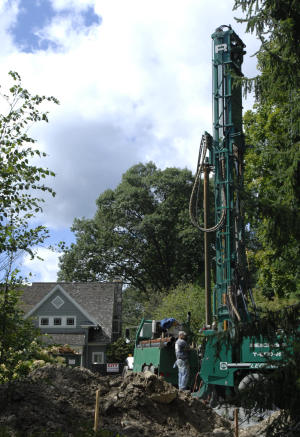Connecticut Wells Residential Geothermal Heat Pump
 Geothermal energy is an efficient, green, reliable, and low maintenance heating and cooling solution. The rate of adoption is increasing and winning market share among new and retrofit residences worldwide.
Geothermal energy is an efficient, green, reliable, and low maintenance heating and cooling solution. The rate of adoption is increasing and winning market share among new and retrofit residences worldwide.
Thousands of geothermal heat pumps are now in operation in the United States and abroad, and the rate of adoption has been increasing as energy costs and dependence on foreign energy sources have risen and as mitigation of global warming has become recognized as an important factor for which we all must share responsibility.
Why Connecticut Wells?
Connecticut Wells is the Northeast’s expert in geothermal heating and cooling systems, which are becoming increasingly popular with private homeowners due to rising gas and oil prices. With more than 50+ years of experience in the well drilling industry, Connecticut Wells has completed more than 1,000+ geothermal heating and cooling projects in NY, CT and throughout the Northeast.
Why Geothermal?
A Cleaner, More Cost-Effective Resource
Studies show that approximately 70% of the energy used in geothermal systems is renewable energy from the ground. The remainder is clean electrical energy, which is used to concentrate heat and transport it from one location to another. In winter, the ground absorbs solar energy and provides a barrier to cold air. In summer, the ground temperature rises more slowly than the outside air.
As a result, owners of geothermal systems typically enjoy utility bills that are 25-70% lower than with conventional systems. In addition, there are lower maintenance costs.
Additional Advantages of Geothermal Energy
Owners of geothermal systems may also experience the following benefits:
- the National Association of Realtors Appraisal Journal estimates that a home’s value increases by $10-25 for every $1 reduction in the annual utility bill
- a higher year-round comfort level than with conventional systems
- peace of mind of knowing they’re being environmentally responsible
- lower greenhouse gas emissions than a conventional furnace
- elimination of a potential source of poisonous carbon monoxide
- little to no maintenance costs (no costly boiler repairs or cleaning)
Getting Started
Once you’ve decided to use geothermal drilling to keep your home warm in winter and cool in summer, you’ll need to take a few steps:
1. Contact Connecticut Wells
The first thing to do is contact Connecticut Wells. We can put you in touch with a qualified HVAC contractor in your area. Your HVAC contractor should be familiar with geothermal technology and be accredited with the International Ground Source Heat Pump Association (IGSHPA).
Feel free to contact us for a list of recommended HVAC contractors in your area.
2. Obtain a Heat Loss Calculation
The most common question people ask us is, “Based on my home’s square footage, how many wells do I need and how much will it cost?” Square footage does not matter in this case: Wells are sized using a “heat loss” calculation, which is a measurement of the home’s efficiency.
To obtain a heat loss calculation, your HVAC contractor will use a procedure known as Manual J. Once your HVAC contractor performs a Manual J study, he or she will give you an accurate heat loss value. That number will be in thousands of BTUs. Every 12,000 BTUs indicates about one ton of heat loss for the building. A typical residence has an average heat loss of five to seven tons. Keep in mind that this is an average and not necessarily what your home needs.
The other important factor, decided by the HVAC contractor and the heat pump manufacturer, is the size, depth and number of the heat pumps to be installed in your home. A heat pump has a rating of efficiency. That number is called the COP, or coefficient of performance. In the early days of geothermal heat pumps, with a COP rating of 2 or 3, it was rule of thumb to use 150 feet of drilling for every ton of equipment installed in the home. As heat pumps became more and more efficient, their COP ratings grew to 4 and 5. Now, for every unit of energy put into a heat pump, it returns 4 or 5 units back into your home. While the heat pump can accept or reject more heat into the earth, linear footage must be added to help absorb that temperature. On average, the wells need to be 180-200 feet per ton.
3. Contact Connecticut Wells
Once you have a heat loss calculation, email our Sales department or call us at (203) 266-5272. We’ll be happy to send you a free written proposal on your ground source geothermal exchange system.
